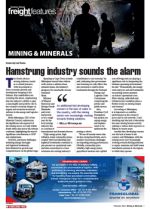Tanzania is strategically positioning itself to emerge as a premier mining hub in East Africa through a comprehensive critical mineral policy. This policy blueprint encompasses various pillars aimed at bolstering the nation's mining sector. Key focus areas include ensuring the reliable supply of critical minerals, stimulating exploration and fostering innovation, all while championing sustainable and responsible mining practices.The strategy, initiated by President Samia Suluhu Hassan, is placing mining centre stage in the country. Tanzania’s goal is to explore its bouquet of mineral resources, ranging from critical minerals, rare earth and precious metals energy to industrial minerals.According to minister of minerals Anthony Mavunde, the African narrative of mining is crumbling. “Tanzania is redefining the script, not with empty promises, but with groundbreaking action, offering transformative partnerships,” he said.Mavunde said mining on the continent had been shrouded in environmental degradation, exploitation and secrecy. “Our vision isn’t to simply dig up minerals, but to ignite the engines of prosperity.”The government has an ambitious strategy on the table for its mining sector to drive investment, economic growth and value addition while focusing on sustainable and responsible mining practices.Tanzanian permanent secretary Kheri Mahimbali said mining was already yielding tangible results in the country. “In 2023, the mining sector contributed to around 10% of our GDP, generating nearly 60% of the country’s foreign exchange, with responsible practices attracting over $2 billion in new investments, led by global mining companies,” he said.“Planned additional commitments will exceed $1bn in the next two to three years, covering critical and rare earth minerals such as graphite, lithium, nickel and neodymium as Tanzania embarks on beneficiation of its mineral deposits.”First on the agenda for the East African country will be the development of a critical mineral policy – a first in sub-Saharan Africa, according to its authorities. “This is about ensuring supply reliability and resiliency, promoting exploration, production as well as innovation. We are also encouraging sustainable and responsible practices. In February, Resource Mining Corporation (RMC) announced it had secured two gold-copper projects spanning 1 580 square kilometres in Tanzania's Ubendian Orogenic Belt. This joint-venture partnership with Vancouver Mineral Resources (VMR) will see RMC take control of the Mpanda and Mbozi projects where it is now planning several feasibility studies. The projects are situated in an area where some of the most significant copper-gold discoveries in Tanzania have been made to date. RCM also has nickel-copper assets in Tanzania, a country that is considered to have high potential for nickel. It has identified several project areas where exploration is under way.In January, Lifezone metals announced its discovery of additional high-grade nickel at its Kabanga nickel project in the country. “Not only is our project believed to be one of the world’s largest and highest-grade undeveloped nickel sulfide deposits, but we have also continued to show that there are new areas for nickel discovery and more potential for resource addition. We have achieved significant results from a limited drill programme to date,” said CEO Chris Showalter. Highlights of initial exploration have included the finding of nickel, copper and cobalt.In the meantime, the country has also upped its game in the oil and gas sector, with the Tanzania Petroleum Development Corp most recently doubling its stake in the Mnazi Bay natural gas field.Tanzania has total recoverable natural gas reserves of 57.54 Tcf. At least $550 million of investment is required for the Mnzi Bay field alone.Hassan’s vision for Tanzania’s economic growth is based on developing oil and gas along with all other metals and minerals. She has firm plans to increase oil and gas production not only to meet domestic demand but also to build export pipelines to neighbouring countries such as Uganda, Zambia, Kenya, and the Democratic Republic of the Congo.

